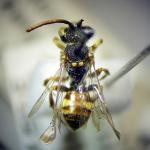In the older literature this species is sometimes cited under the name Nomada baeri Stöckhert, 1930; a name now treated as a junior synonym of castellana.
A small species with a body length of 5–7 mm. In the field it most resembles Nomada conjungens Herrich-Schäffer and Nomada flavoguttata (Kirby) in both size and coloration and could easily be passed over as being those species. The main distinguishing characters (colour and form of the labrum in the female, and shape of the intermediate flagellar segments in the male) are best viewed under a binocular microscope. The species is included in a recent key to the bees of Switzerland (Amiet et al., 2007).
The only record is a male collected in Jersey, Channel Islands, by A C Warne (St Mary, Malaise trap, 26th June 1991 (BMNH)).
This is a little known species that is apparently widely distributed in western Europe but is sporadic and generally rare. There are, for example, records from Spain, Switzerland and Austria.
The Channel Islands, for a number of reasons, are excluded from the geographical coverage of the British Red Data book (Shirt, 1987). Its status on the islands is not known.
Not known.
Univoltine; late April to mid July.
In mainland Europe this species is a cleptoparasite of certain species of Andrena in the subgenus Micrandrena, possibly including Andrena anthrisci Blüthgen (a species not found in the British Isles) and Andrena alfkenella Perkins (Stöckhert, 1954; Amiet et al., 2007). The host species in Jersey is not known.
No records available for the Channel Islands.
None known.
2016


